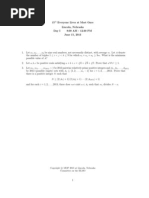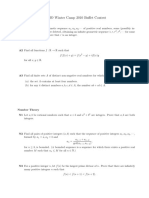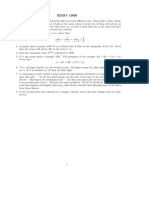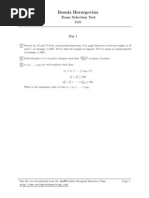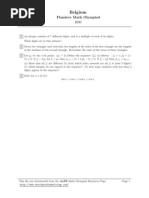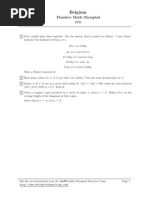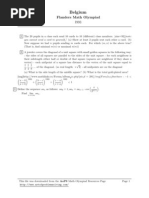Rioplatense Mathematical Olympiad, Level 3-2006
Rioplatense Mathematical Olympiad, Level 3-2006
Uploaded by
OklaCopyright:
Available Formats
Rioplatense Mathematical Olympiad, Level 3-2006
Rioplatense Mathematical Olympiad, Level 3-2006
Uploaded by
OklaCopyright
Available Formats
Share this document
Did you find this document useful?
Is this content inappropriate?
Copyright:
Available Formats
Rioplatense Mathematical Olympiad, Level 3-2006
Rioplatense Mathematical Olympiad, Level 3-2006
Uploaded by
OklaCopyright:
Available Formats
Rioplatense Mathematical Olympiad, Level 3 2006
Day 1
1 (a) For each integer k 3, nd a positive integer n that can be represented as the sum of exactly k mutually distinct positive divisors of n. (b) Suppose that n can be expressed as the sum of exactly k mutually distinct positive divisors of n for some k 3. Let p be the smallest prime divisor of n. Show that 1 1 1 + + + 1. p p+1 p+k1 2 Let ABCD be a convex quadrilateral with AB = AD and CB = CD. The bisector of BDC intersects BC at L, and AL intersects BD at M , and it is known that BL = BM . Determine the value of 2BAD + 3BCD. 3 The numbers 1, 2, . . . , 2006 are written around the circumference of a circle. A move consists of exchanging two adjacent numbers. After a sequence of such moves, each number ends up 13 positions to the right of its initial position. lf the numbers 1, 2, . . . , 2006 are partitioned into 1003 distinct pairs, then show that in at least one of the moves, the two numbers of one of the pairs were exchanged.
This le was downloaded from the AoPS Math Olympiad Resources Page http://www.artofproblemsolving.com/
Page 1
Rioplatense Mathematical Olympiad, Level 3 2006
Day 2
1 The acute triangle ABC with AB = AC has circumcircle , circumcenter O, and orthocenter H . The midpoint of BC is M , and the extension of the median AM intersects at N . The circle of diameter AM intersects again at A and P . Show that the lines AP , BC , and OH are concurrent if and only if AH = HN . 2 A given nite number of lines in the plane, no two of which are parallel and no three of which are concurrent, divide the plane into nite and innite regions. In each nite region we write 1 or 1. In one operation, we can choose any triangle made of three of the lines (which may be cut by other lines in the collection) and multiply by 1 each of the numbers in the triangle. Determine if it is always possible to obtain 1 in all the nite regions by successively applying this operation, regardless of the initial distribution of 1s and 1s. 3 An innite sequence x1 , x2 , . . . of positive integers satises xn+2 = gcd(xn+1 , xn ) + 2006 for each positive integer n. Does there exist such a sequence which contains exactly 102006 distinct numbers?
This le was downloaded from the AoPS Math Olympiad Resources Page http://www.artofproblemsolving.com/
Page 2
You might also like
- Luke Math OlysDocument7 pagesLuke Math OlysStefy StefanNo ratings yet
- Russia All Russian Olympiad 2008 61Document3 pagesRussia All Russian Olympiad 2008 61Nick AletNo ratings yet
- International Competitions IMO Shortlist 2000 17Document6 pagesInternational Competitions IMO Shortlist 2000 17Berce GabrielNo ratings yet
- IOQM2Document4 pagesIOQM2aditya.nasa2020No ratings yet
- ProblemsDocument9 pagesProblemsimmortaldeanNo ratings yet
- IMO2012SLDocument52 pagesIMO2012SLtruongvinhlan19895148No ratings yet
- International Competitions IMO Shortlist 1960 17Document8 pagesInternational Competitions IMO Shortlist 1960 17Marcelo BarbosaNo ratings yet
- 2015 Spain Mathematical OlympiadDocument2 pages2015 Spain Mathematical Olympiadakterb371No ratings yet
- Aops Community 2018 Belarusian National OlympiadDocument4 pagesAops Community 2018 Belarusian National Olympiadmedmohammad078No ratings yet
- IMO Shortlist 2006 Original Without SolutionsDocument8 pagesIMO Shortlist 2006 Original Without SolutionsPhạm An ViênNo ratings yet
- AIME Problem SetDocument3 pagesAIME Problem SetEugene ChenNo ratings yet
- Nordic Mathematical Contest Problems and Solutions, 1987-2011 ProblemsDocument68 pagesNordic Mathematical Contest Problems and Solutions, 1987-2011 ProblemsCangKangNo ratings yet
- India: Regional Mathematical Olympiad 2011Document2 pagesIndia: Regional Mathematical Olympiad 2011Madhav SainaneeNo ratings yet
- International Competitions IMO Shortlist 2013 17Document6 pagesInternational Competitions IMO Shortlist 2013 17Trảm VõNo ratings yet
- India International Mathematical Olympiad Training Camp-2013Document5 pagesIndia International Mathematical Olympiad Training Camp-2013Himansu MookherjeeNo ratings yet
- IOQM 2022 Practice Test-09Document3 pagesIOQM 2022 Practice Test-09Aaditya SinghNo ratings yet
- Rice MathDocument60 pagesRice MathHarikrishna ShenoyNo ratings yet
- International - Competitions IMO 2013 16 PDFDocument2 pagesInternational - Competitions IMO 2013 16 PDFPaopao FonolleraNo ratings yet
- Awesomemath Team Contest - Cornell 2013: AlgebraDocument2 pagesAwesomemath Team Contest - Cornell 2013: Algebraสนธยา เสนามนตรีNo ratings yet
- 2018 Geometry FebruaryDocument6 pages2018 Geometry FebruaryNadine SouzaNo ratings yet
- IMO Shortlist 1997Document4 pagesIMO Shortlist 1997quaned2k5No ratings yet
- 3955hhshshshDocument6 pages3955hhshshshTiltTheTiltNo ratings yet
- First Day: Imo QuestionsDocument1 pageFirst Day: Imo QuestionsdrssagrawalNo ratings yet
- 51th Mathematical Olympiad in Poland Problems of The First Round, September - December 1999Document1 page51th Mathematical Olympiad in Poland Problems of The First Round, September - December 1999José Maurício FreireNo ratings yet
- Czech-Polish-Slovak Junior Match 2023Document2 pagesCzech-Polish-Slovak Junior Match 2023eulerfermat229No ratings yet
- 2014 Indonesia MO: Contributors: Chaotic IakDocument2 pages2014 Indonesia MO: Contributors: Chaotic IakAldo MateosNo ratings yet
- INTEGERSDocument7 pagesINTEGERSrkhnk2023No ratings yet
- IMO ShortList 2012 ProblemsDocument6 pagesIMO ShortList 2012 ProblemsZadaci AopsNo ratings yet
- Elmo 2013 d1 d2 FinalDocument2 pagesElmo 2013 d1 d2 FinalDheliaNo ratings yet
- 1994 Savezno eDocument2 pages1994 Savezno eSlaven007No ratings yet
- Problem Set 1: Tahmid Hameem Chowdhury September 26, 2019Document3 pagesProblem Set 1: Tahmid Hameem Chowdhury September 26, 2019FuadAlAlamNo ratings yet
- Buffet Contest - X - Canada 2010Document2 pagesBuffet Contest - X - Canada 2010Ayush AryanNo ratings yet
- 7 Mathlinks Contest: N 1 I I N N I I I I+1Document7 pages7 Mathlinks Contest: N 1 I I N N I I I I+1ferrousweiNo ratings yet
- Aops Community 2024 Caucasus Mathematical OlympiadDocument3 pagesAops Community 2024 Caucasus Mathematical Olympiadeulerfermat229No ratings yet
- Competition Corner (Tay Tiong Seng)Document20 pagesCompetition Corner (Tay Tiong Seng)hungkgNo ratings yet
- Usamo 2013: Day 1 - 30 April 2013Document2 pagesUsamo 2013: Day 1 - 30 April 2013truongvinhlan19895148No ratings yet
- IMO2012 Shortlisted Problems with SolutionsDocument52 pagesIMO2012 Shortlisted Problems with SolutionsmyfavouritehippoNo ratings yet
- Shary GinDocument23 pagesShary Ginakterb371No ratings yet
- Aops Community 2017 Dutch Imo TSTDocument2 pagesAops Community 2017 Dutch Imo TSTMuhammad Taufan FathurrachmanNo ratings yet
- Italy ITAMO 2013 92Document1 pageItaly ITAMO 2013 92Aldo MateosNo ratings yet
- RMO Previous Year PapersDocument145 pagesRMO Previous Year PapersGarvit AhujaNo ratings yet
- Iran-National Math Olympiad 3rd Round-1998-101Document4 pagesIran-National Math Olympiad 3rd Round-1998-101Biswarup BurmanNo ratings yet
- Rmo Pyq (1990-1999)Document10 pagesRmo Pyq (1990-1999)prashantjainioqmNo ratings yet
- RMODocument97 pagesRMO6C-30-Akshit SinghNo ratings yet
- Pre-IMOTC 2018Document5 pagesPre-IMOTC 2018rehan khanNo ratings yet
- ProblemsDocument7 pagesProblemsNITESH BHARGAV100% (1)
- 3 FdabfDocument5 pages3 Fdabfghanesh253No ratings yet
- Geo Cross RatioDocument31 pagesGeo Cross Ratioclrgeek100% (1)
- Rmo Pyq's MergedDocument105 pagesRmo Pyq's Mergedkinocet923No ratings yet
- Prmo 2018 QPDocument2 pagesPrmo 2018 QPJatin RatheeNo ratings yet
- 1965 EngDocument2 pages1965 EngChhorvorn VannNo ratings yet
- Review Assignment - PRMO: (For XI & XII Studying Students)Document12 pagesReview Assignment - PRMO: (For XI & XII Studying Students)Sapna Agrawal100% (1)
- TJUSAMO 2012-2013 Graph TheoryDocument2 pagesTJUSAMO 2012-2013 Graph TheoryChanthana ChongchareonNo ratings yet
- Aops Community 2018 Baltic WayDocument3 pagesAops Community 2018 Baltic WayMd HajjulNo ratings yet
- ProblemsDocument9 pagesProblemsmadhavatloye667zNo ratings yet
- Seventh Internatioaal Olympiad, 1965Document2 pagesSeventh Internatioaal Olympiad, 1965Claudiu PopescuNo ratings yet
- Xvii Geometrical Olympiad in Honour of I.F.Sharygin The Correspondence RoundDocument4 pagesXvii Geometrical Olympiad in Honour of I.F.Sharygin The Correspondence RoundRaghav GoelNo ratings yet
- Bosnia Herzegovina Team Selection Test 2008Document2 pagesBosnia Herzegovina Team Selection Test 2008OklaNo ratings yet
- Canada National Olympiad 1969Document1 pageCanada National Olympiad 1969OklaNo ratings yet
- Canada Gauss 1999Document2 pagesCanada Gauss 1999OklaNo ratings yet
- Canada-Canadian Open Math Challenge-2011Document3 pagesCanada-Canadian Open Math Challenge-2011Okla100% (1)
- Bosnia Herzegovina Team Selection Test 2009Document2 pagesBosnia Herzegovina Team Selection Test 2009OklaNo ratings yet
- Canada-Canadian Open Math Challenge-1996Document2 pagesCanada-Canadian Open Math Challenge-1996OklaNo ratings yet
- Canada Canadian Students Math Olympiad 2011Document1 pageCanada Canadian Students Math Olympiad 2011OklaNo ratings yet
- Bosnia Herzegovina Team Selection Test 2011Document2 pagesBosnia Herzegovina Team Selection Test 2011OklaNo ratings yet
- Belgium Flanders Math Olympiad 2005Document1 pageBelgium Flanders Math Olympiad 2005OklaNo ratings yet
- Bosnia Herzegovina Regional Olympiad 2008Document4 pagesBosnia Herzegovina Regional Olympiad 2008OklaNo ratings yet
- Belgium Flanders Math Olympiad 2006Document1 pageBelgium Flanders Math Olympiad 2006OklaNo ratings yet
- Belgium Flanders Math Olympiad 2000Document1 pageBelgium Flanders Math Olympiad 2000OklaNo ratings yet
- Belgium Flanders Math Olympiad 2002Document1 pageBelgium Flanders Math Olympiad 2002OklaNo ratings yet
- Belgium Flanders Math Olympiad 2004Document2 pagesBelgium Flanders Math Olympiad 2004OklaNo ratings yet
- Belgium Flanders Math Olympiad 2001Document1 pageBelgium Flanders Math Olympiad 2001OklaNo ratings yet
- Belgium Flanders Math Olympiad 2003Document2 pagesBelgium Flanders Math Olympiad 2003OklaNo ratings yet
- Belgium Flanders Math Olympiad 1995Document1 pageBelgium Flanders Math Olympiad 1995OklaNo ratings yet
- Belgium Flanders Math Olympiad 1999Document1 pageBelgium Flanders Math Olympiad 1999OklaNo ratings yet
- Belgium Flanders Math Olympiad 1996Document1 pageBelgium Flanders Math Olympiad 1996OklaNo ratings yet
- Belgium Flanders Math Olympiad 1997Document1 pageBelgium Flanders Math Olympiad 1997OklaNo ratings yet
- Belgium Flanders Math Olympiad 1998Document1 pageBelgium Flanders Math Olympiad 1998OklaNo ratings yet
- Belgium Flanders Math Olympiad 1989Document1 pageBelgium Flanders Math Olympiad 1989OklaNo ratings yet
- Belgium Flanders Math Olympiad 1994Document1 pageBelgium Flanders Math Olympiad 1994OklaNo ratings yet
- Belgium Flanders Math Olympiad 1986Document1 pageBelgium Flanders Math Olympiad 1986OklaNo ratings yet
- Belgium Flanders Math Olympiad 1991Document1 pageBelgium Flanders Math Olympiad 1991OklaNo ratings yet
- Belgium Flanders Math Olympiad 1990Document1 pageBelgium Flanders Math Olympiad 1990OklaNo ratings yet
- Belgium Flanders Math Olympiad 1992Document1 pageBelgium Flanders Math Olympiad 1992OklaNo ratings yet
- Belgium Flanders Math Olympiad 1993Document1 pageBelgium Flanders Math Olympiad 1993OklaNo ratings yet
- Belgium Flanders Math Olympiad 1988Document1 pageBelgium Flanders Math Olympiad 1988OklaNo ratings yet
- Belgium Flanders Math Olympiad 1987Document1 pageBelgium Flanders Math Olympiad 1987OklaNo ratings yet




























